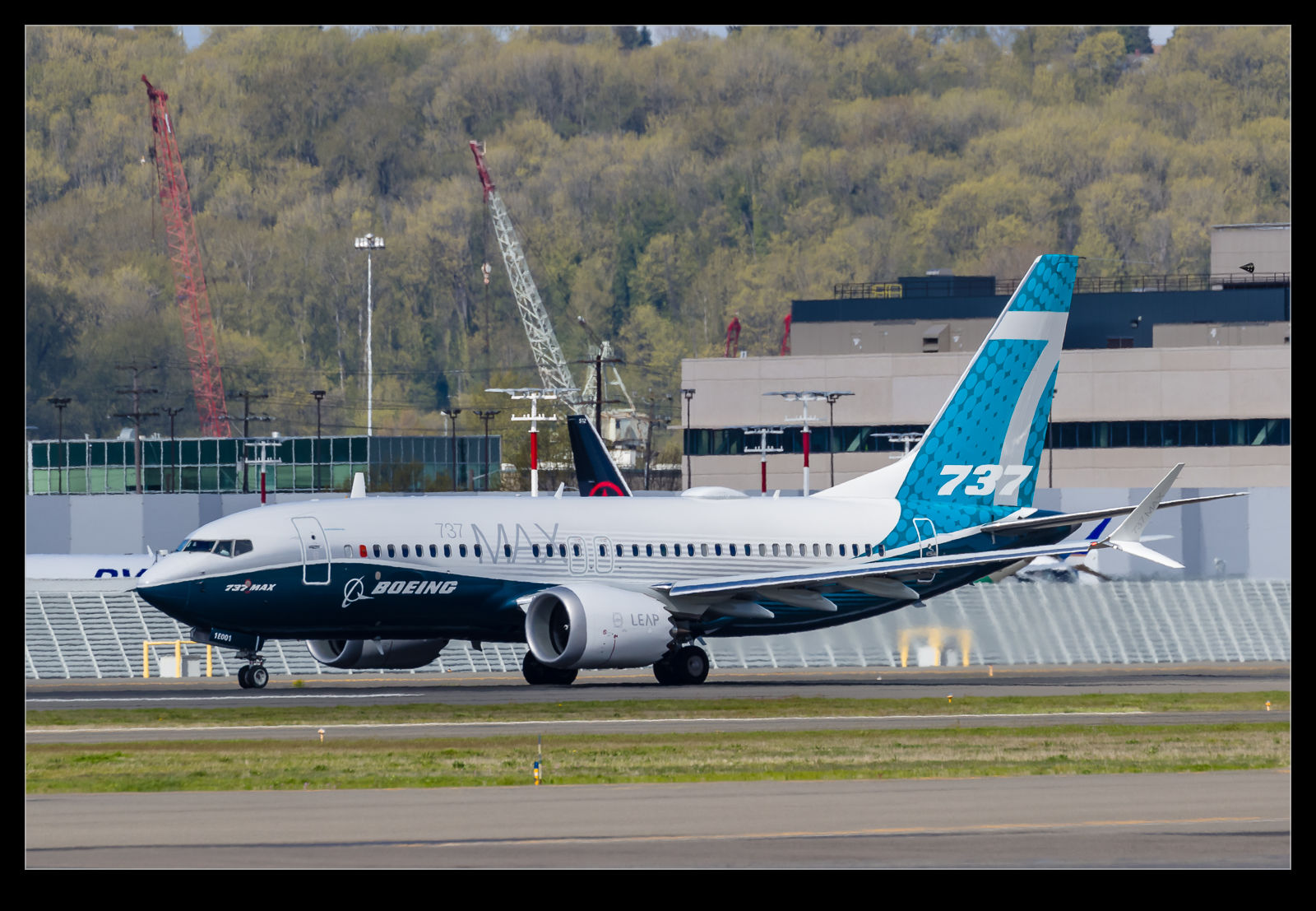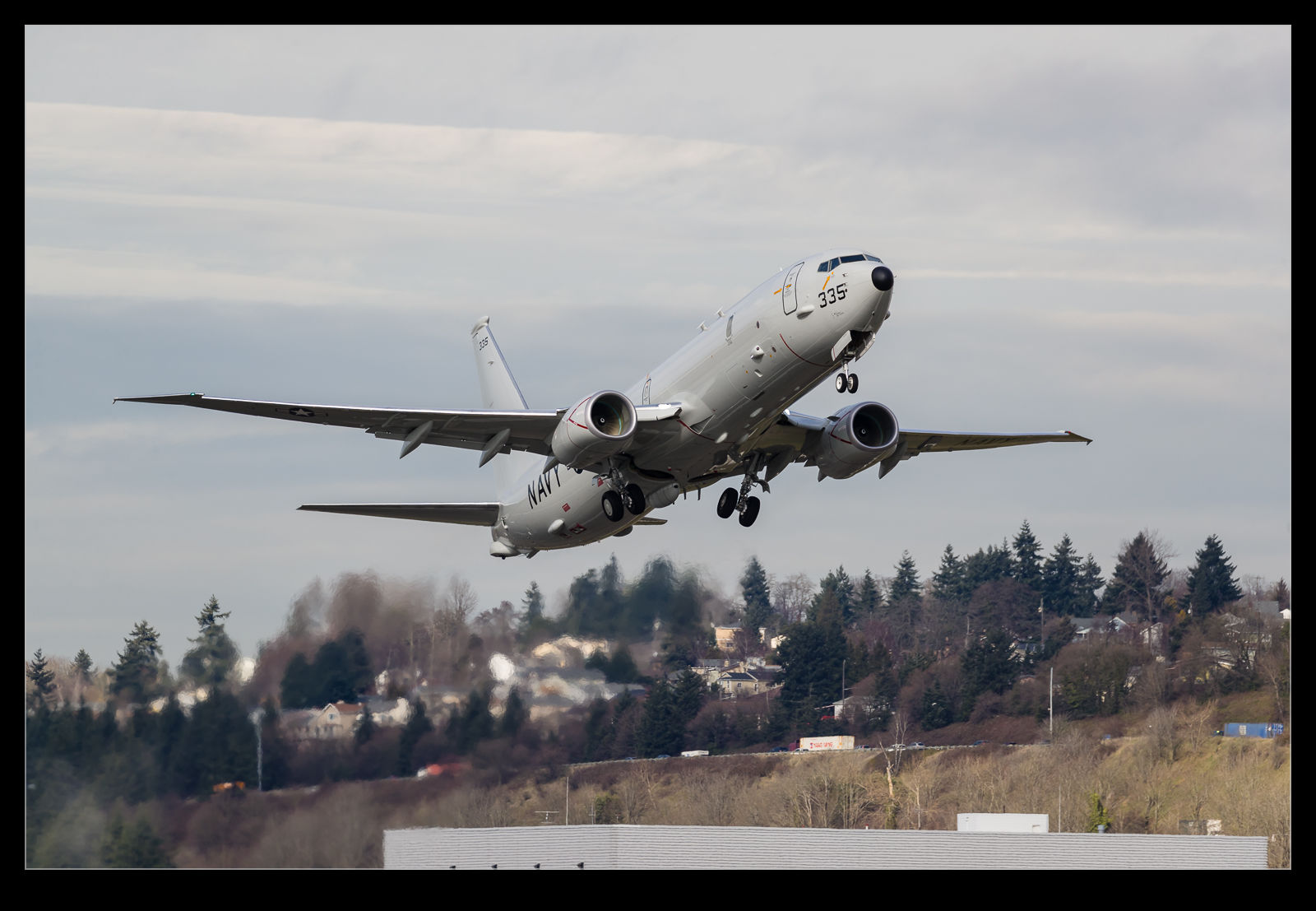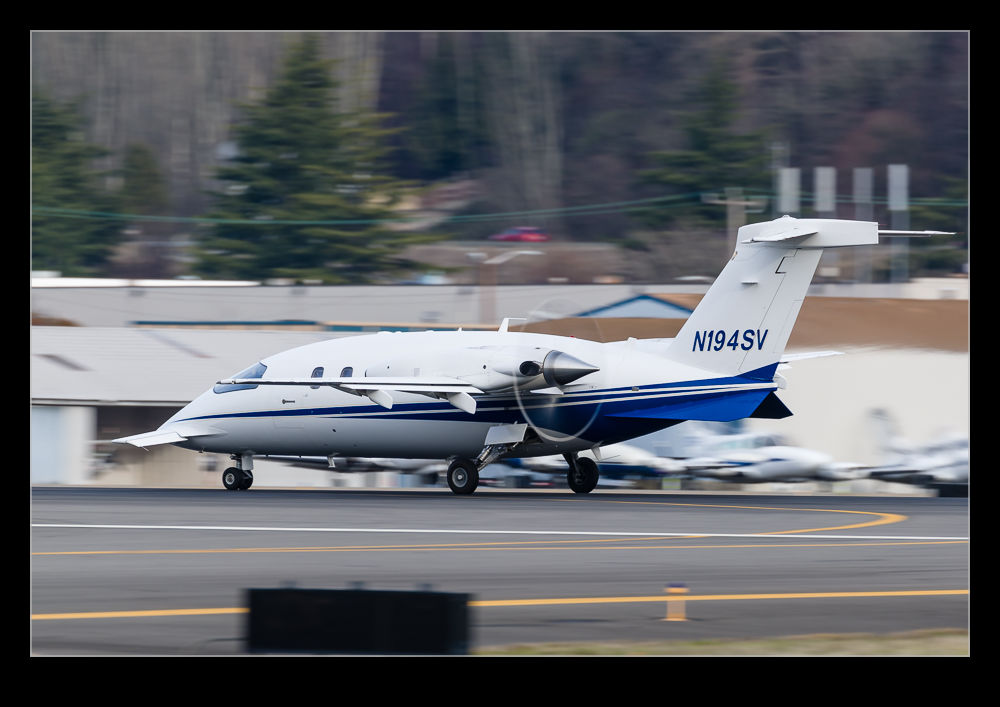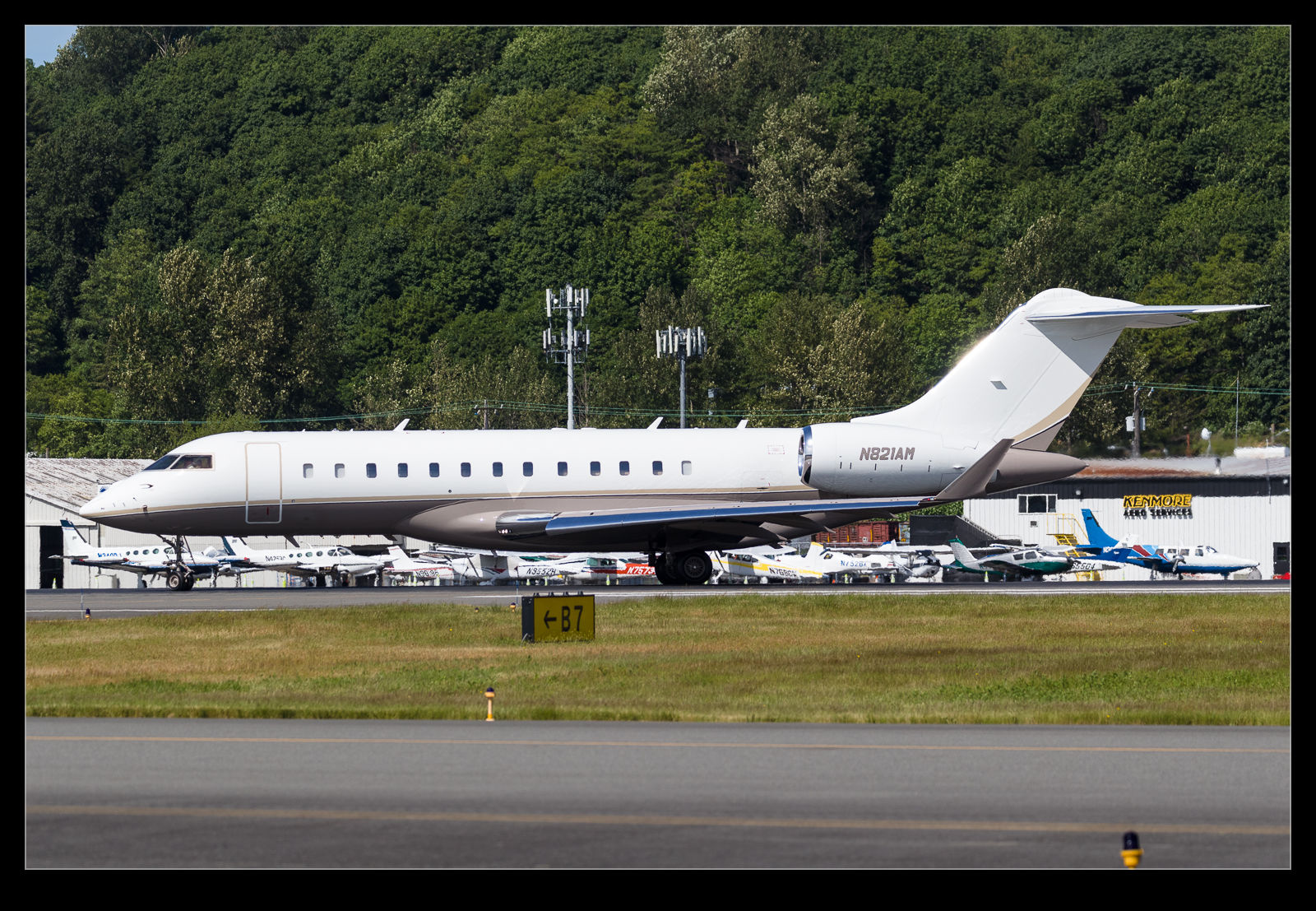 Biz jets often look samey but a cool livery gets a second look. This Gulfstream was at Boeing Field. I don’t think I need to explain why I shot it…
Biz jets often look samey but a cool livery gets a second look. This Gulfstream was at Boeing Field. I don’t think I need to explain why I shot it…
Tag Archives: KBFI
Max7 Test Aircraft
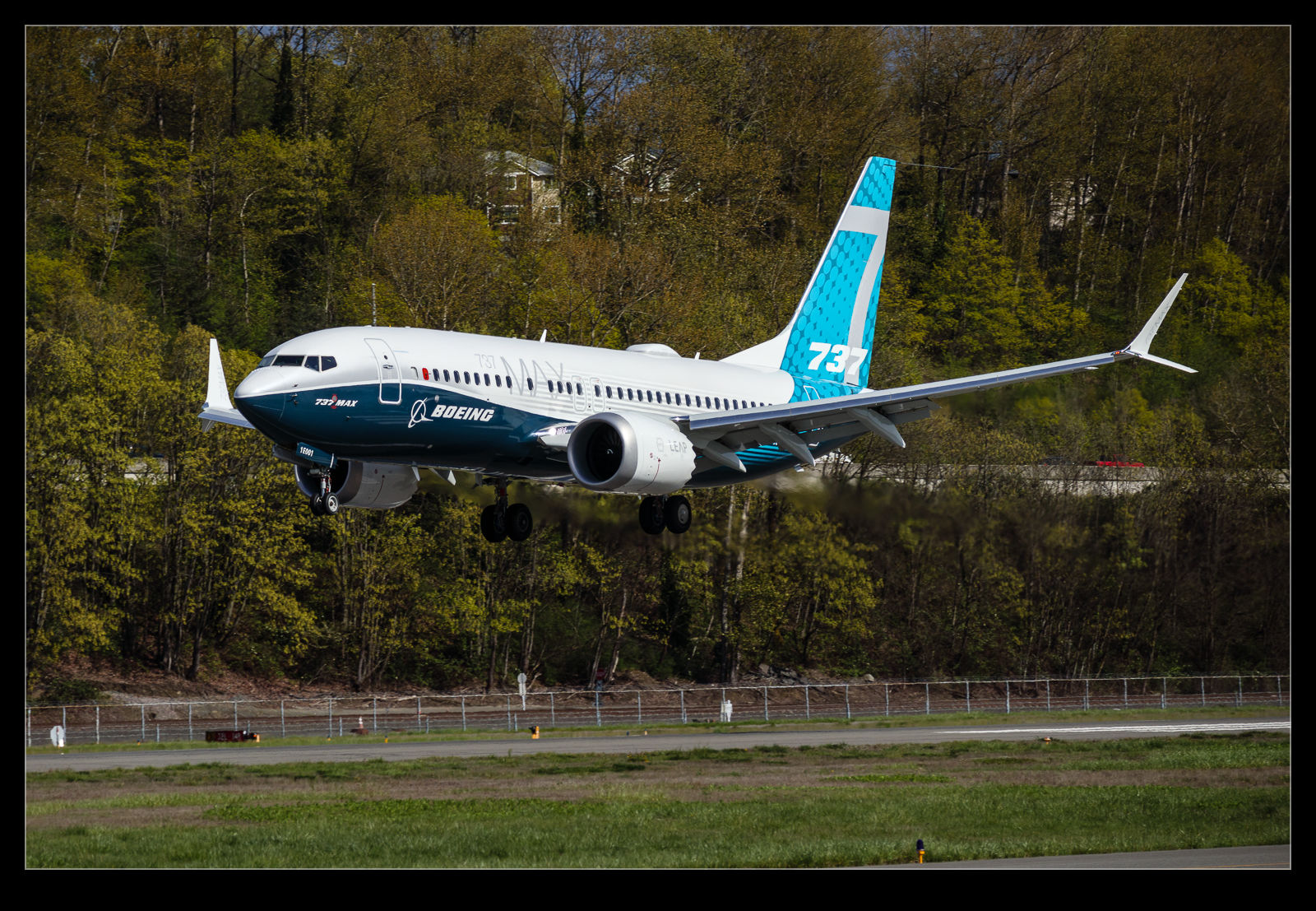 The 737 Max8 and Max9 Jets are both certificated and in service. Next to come along is the Max7. It is a lower priority as a result of a far lower level of orders combined with a redesign it underwent to make it larger than originally intended. It is now flying though. I saw one aircraft on the ramp at Renton when passing by and also saw the first test aircraft landing at Boeing Field. I actually saw it take off as I drove in to the city heading to a meeting and it returned at the end of the day. Neither the Max7 nor the A319neo has sold well so it will be interesting to see how many of these enter service.
The 737 Max8 and Max9 Jets are both certificated and in service. Next to come along is the Max7. It is a lower priority as a result of a far lower level of orders combined with a redesign it underwent to make it larger than originally intended. It is now flying though. I saw one aircraft on the ramp at Renton when passing by and also saw the first test aircraft landing at Boeing Field. I actually saw it take off as I drove in to the city heading to a meeting and it returned at the end of the day. Neither the Max7 nor the A319neo has sold well so it will be interesting to see how many of these enter service.
Pegasus Testing with the Hornet (and it’s not raining)
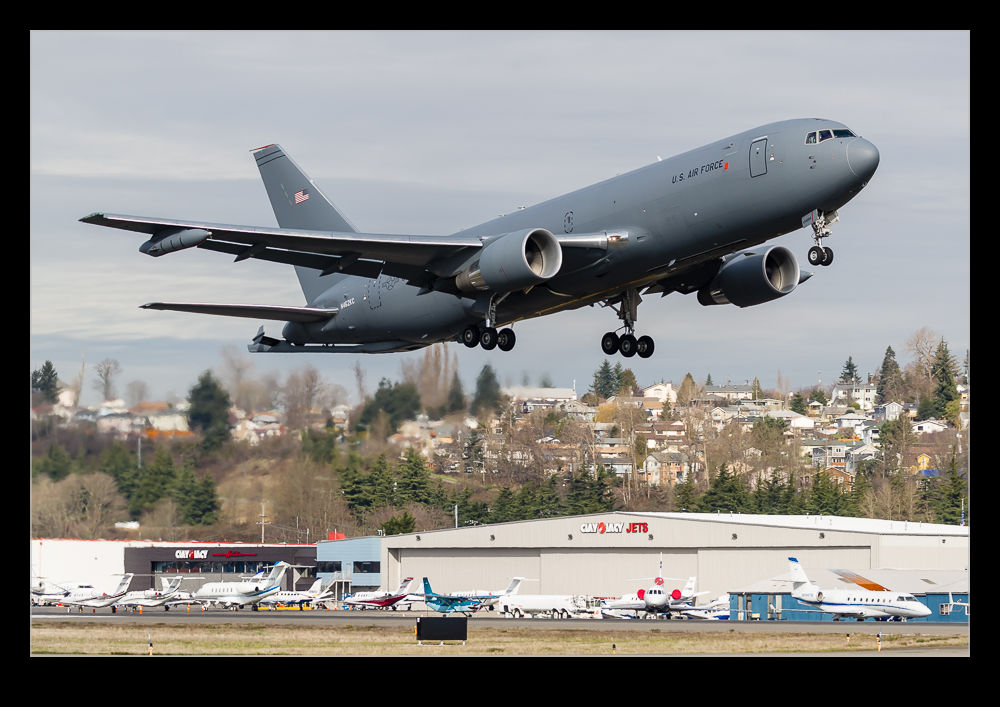 My luck with KC-46s and bad weather broke recently with a Pegasus launching out of Boeing Field on a glorious day. It was carrying out trials work with a US Navy Hornet. This jet was the subject of its own post. The KC-46 followed it down the runway. It rotated in a good location and the light was so much nicer than I have had recently so I was very happy to get shots of it as it climbed out and headed off to the airspace set aside for testing.
My luck with KC-46s and bad weather broke recently with a Pegasus launching out of Boeing Field on a glorious day. It was carrying out trials work with a US Navy Hornet. This jet was the subject of its own post. The KC-46 followed it down the runway. It rotated in a good location and the light was so much nicer than I have had recently so I was very happy to get shots of it as it climbed out and headed off to the airspace set aside for testing.
P-8 Heads Out on Test
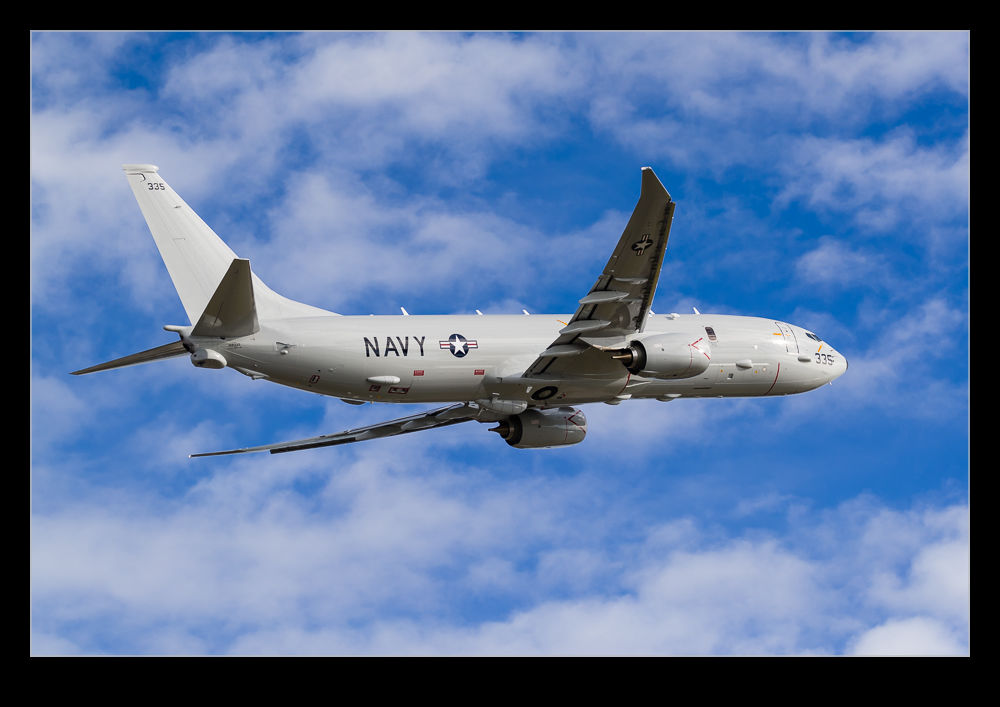 Every once in a while, you just get lucky. I happened to be at Boeing Field on a sunny day with operations in a southerly direction and a bunch of cool traffic. Most of the traffic shows up on Flightaware so you have a clue it might be flying but my recent experiences have been that the P-8 test flights have not been listed. Consequently, I was a little surprised when a P-8 pulled out of Boeing’s military operations ramp and taxied for departure. It came right past me as it made its way to the departure end. A short while later it rolled.
Every once in a while, you just get lucky. I happened to be at Boeing Field on a sunny day with operations in a southerly direction and a bunch of cool traffic. Most of the traffic shows up on Flightaware so you have a clue it might be flying but my recent experiences have been that the P-8 test flights have not been listed. Consequently, I was a little surprised when a P-8 pulled out of Boeing’s military operations ramp and taxied for departure. It came right past me as it made its way to the departure end. A short while later it rolled.
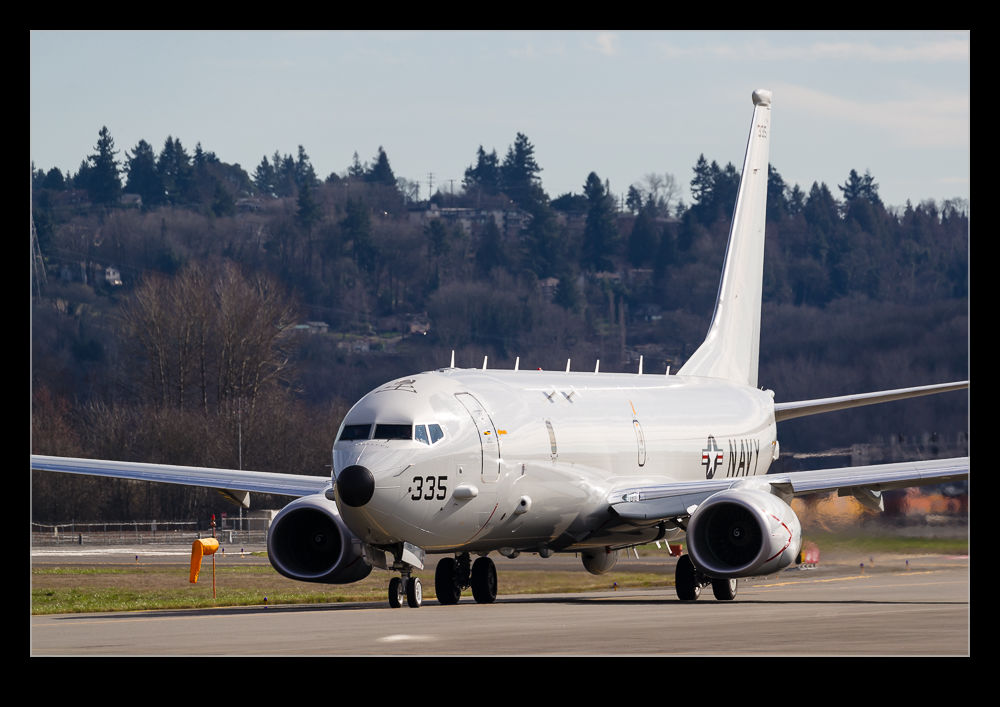 The sun was out, the light was nice, they rotated at a good location to get some nice shots and then, as they climbed out, the clouds were really nice providing a mottled sort of background. The colors looked great behind the grey jet. What a great combination!
The sun was out, the light was nice, they rotated at a good location to get some nice shots and then, as they climbed out, the clouds were really nice providing a mottled sort of background. The colors looked great behind the grey jet. What a great combination!
Sure, Wait for the Storm
 When the weather starts to turn, you can assume that whatever you are waiting for is likely to show up just after it gets bad. In this case, a KC-46 Pegasus was on its way back to Boeing Field and the clouds were rolling in. Things were getting darker and it looked like the clouds would open. Meanwhile, the KC-46 was still a distance away.
When the weather starts to turn, you can assume that whatever you are waiting for is likely to show up just after it gets bad. In this case, a KC-46 Pegasus was on its way back to Boeing Field and the clouds were rolling in. Things were getting darker and it looked like the clouds would open. Meanwhile, the KC-46 was still a distance away.
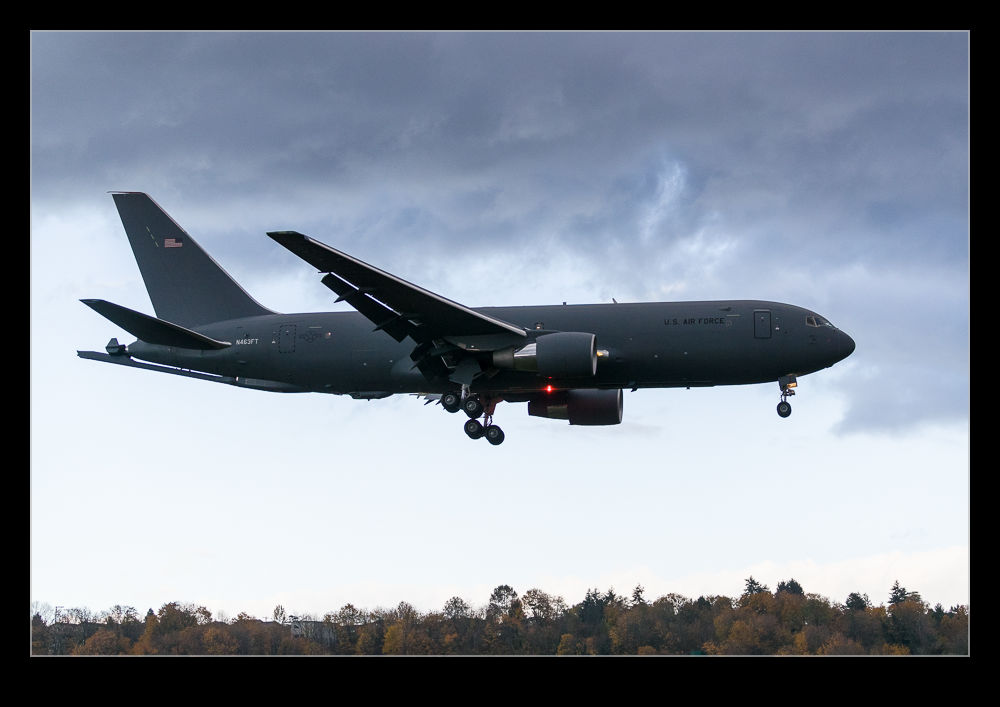 Sure enough, the skies opened. By the time the jet was on final approach, the light had disappeared and the rain was belting down. I got some shots of it but, even with a bunch of exposure compensation, the jet was more of a silhouette than anything else. A little post processing help brought out the detail but this was not an ideal shooting situation. A dark grey jet in dying light is just what you want!
Sure enough, the skies opened. By the time the jet was on final approach, the light had disappeared and the rain was belting down. I got some shots of it but, even with a bunch of exposure compensation, the jet was more of a silhouette than anything else. A little post processing help brought out the detail but this was not an ideal shooting situation. A dark grey jet in dying light is just what you want!
Trailing Static Cones
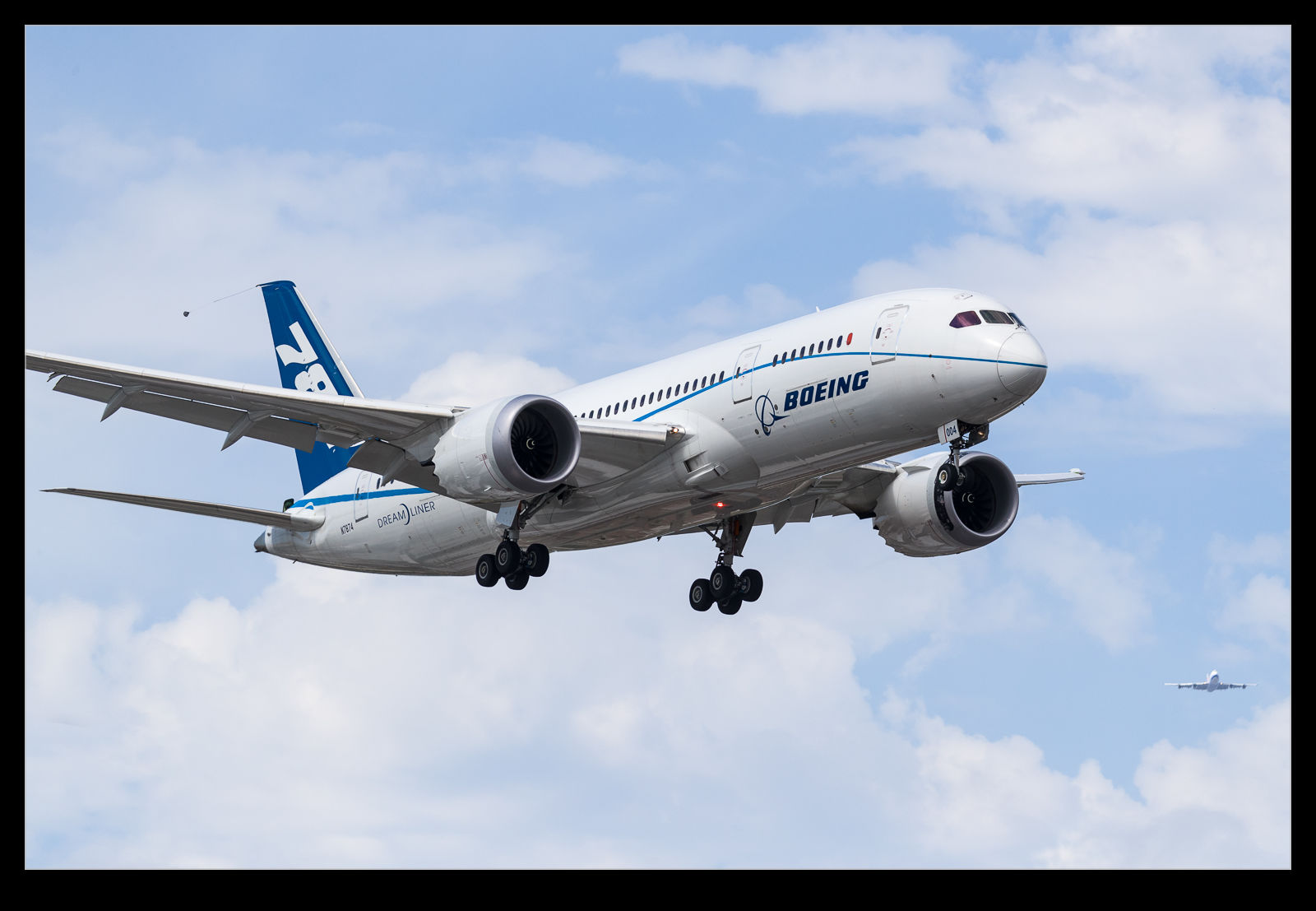 For the people that don’t care for my aviation posts, this one won’t be of interest. For the aviation fans that don’t care about the techie stuff, this will also be of limited interest. That probably leaves a very small group of readers by now (Gary, I am trusting you are still here). This is about a piece of flight test instrumentation that often causes questions when people see it. It is the trailing static cone.
For the people that don’t care for my aviation posts, this one won’t be of interest. For the aviation fans that don’t care about the techie stuff, this will also be of limited interest. That probably leaves a very small group of readers by now (Gary, I am trusting you are still here). This is about a piece of flight test instrumentation that often causes questions when people see it. It is the trailing static cone.
 The aircraft has sensors that measure air data, two of the most important of which are the pitot probe and the static port. The pitot probe measures the dynamic pressure of the air which increases as the speed increases. The static port measures the air around the aircraft. The difference between the two is used to determine the speed of the aircraft and the static is used to determine the altitude. These are both vital information for a pilot. However, the aircraft affects the flow of the air around it so, while you can calculate what the pressures should be, you need to validate what the actual readings are. The first flights are carried out prior to calibrating the system so you need to have a bit of margin in the speeds you use until you have confidence in the readings.
The aircraft has sensors that measure air data, two of the most important of which are the pitot probe and the static port. The pitot probe measures the dynamic pressure of the air which increases as the speed increases. The static port measures the air around the aircraft. The difference between the two is used to determine the speed of the aircraft and the static is used to determine the altitude. These are both vital information for a pilot. However, the aircraft affects the flow of the air around it so, while you can calculate what the pressures should be, you need to validate what the actual readings are. The first flights are carried out prior to calibrating the system so you need to have a bit of margin in the speeds you use until you have confidence in the readings.
 Measuring static pressure is hard to do. The plane will have a static port on the skin of the plane as well as possibly incorporated with the pitot head. However, the air has accelerated to go around the fuselage so it is assumed to have a lower pressure than ambient. Because the plane is disturbing the flow, you need a way to measure the pressure some distance away from the plane. The answer is a trailing static cone.
Measuring static pressure is hard to do. The plane will have a static port on the skin of the plane as well as possibly incorporated with the pitot head. However, the air has accelerated to go around the fuselage so it is assumed to have a lower pressure than ambient. Because the plane is disturbing the flow, you need a way to measure the pressure some distance away from the plane. The answer is a trailing static cone.
 This cone incorporates pressure measurement sensors and it attached to a long cable. This is held on a reel inside the aircraft and fed out of the aircraft at the rear. For airliners, this is usually through a modification to the top of the fin. A comparison between the test aircraft and a production jet will show the different structure. The cable dangles out of the fin and, as the speed increases, the cone pulls the cable taught and streams backwards.
This cone incorporates pressure measurement sensors and it attached to a long cable. This is held on a reel inside the aircraft and fed out of the aircraft at the rear. For airliners, this is usually through a modification to the top of the fin. A comparison between the test aircraft and a production jet will show the different structure. The cable dangles out of the fin and, as the speed increases, the cone pulls the cable taught and streams backwards.
 When the testing is required, the cable is winched out and the cone is a long way behind the aircraft in what is relatively undisturbed airflow. If you go to the Museum of Flight, the prototype 747 is on display and it includes the trailing cone equipment in the fuselage. The reel is shown in its mounting location and the trailing cone is hung inside to allow you to take a look at it.
When the testing is required, the cable is winched out and the cone is a long way behind the aircraft in what is relatively undisturbed airflow. If you go to the Museum of Flight, the prototype 747 is on display and it includes the trailing cone equipment in the fuselage. The reel is shown in its mounting location and the trailing cone is hung inside to allow you to take a look at it.
Two Avantis in One Go!
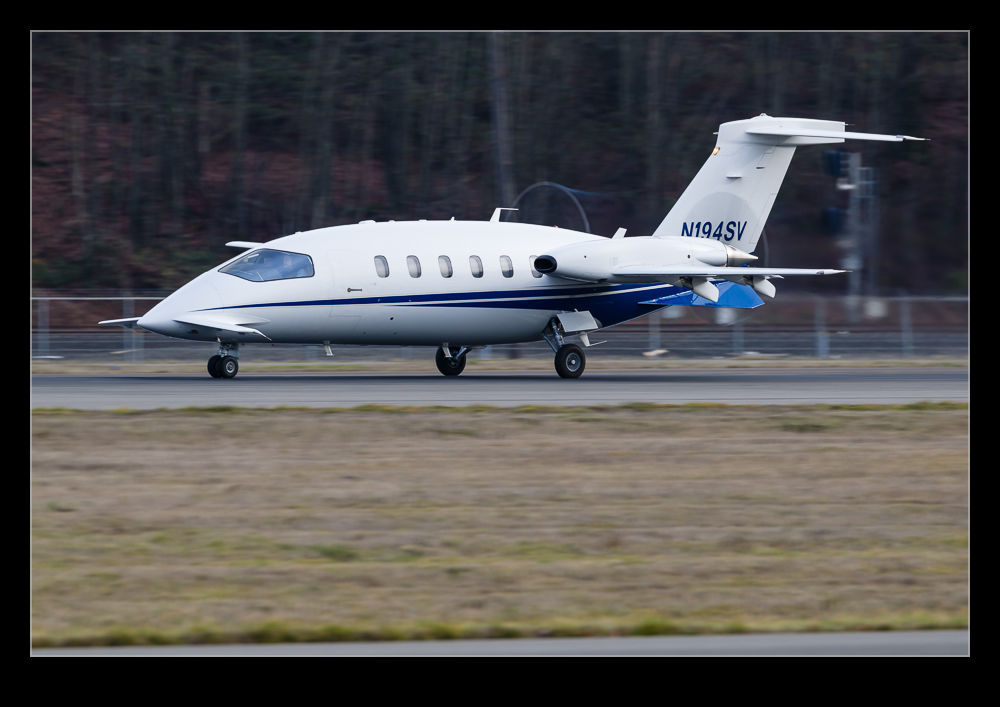 Not long ago, I posted about seeing an Avanti for the first time in a while. The lack of Avantis having been broken, I have seen a couple more. I saw that one had come in to Boeing Field and I was there before it fired up for its next flight. It taxied out on the opposite side of the field and then took off to the northeast.
Not long ago, I posted about seeing an Avanti for the first time in a while. The lack of Avantis having been broken, I have seen a couple more. I saw that one had come in to Boeing Field and I was there before it fired up for its next flight. It taxied out on the opposite side of the field and then took off to the northeast.
 A short while later, I saw a silhouette of a plane on approach and looked closer to see what it was. It looked pretty like an Avanti so I figured it was the same aircraft returning for some reason. I was a bit bothered that something might be wrong but happy to get another chance to shoot it. As it got closer thought, it was clearly not in the same paint scheme. Instead, it turned out to be a Canadian registered example and a pretty nice looking one at that.
A short while later, I saw a silhouette of a plane on approach and looked closer to see what it was. It looked pretty like an Avanti so I figured it was the same aircraft returning for some reason. I was a bit bothered that something might be wrong but happy to get another chance to shoot it. As it got closer thought, it was clearly not in the same paint scheme. Instead, it turned out to be a Canadian registered example and a pretty nice looking one at that.
 Getting two Avantis within a short space of time was an outcome I was pretty pleased with. Unfortunately, I couldn’t hang around to get the departure of the second example.
Getting two Avantis within a short space of time was an outcome I was pretty pleased with. Unfortunately, I couldn’t hang around to get the departure of the second example.
Are These Globals Twins?
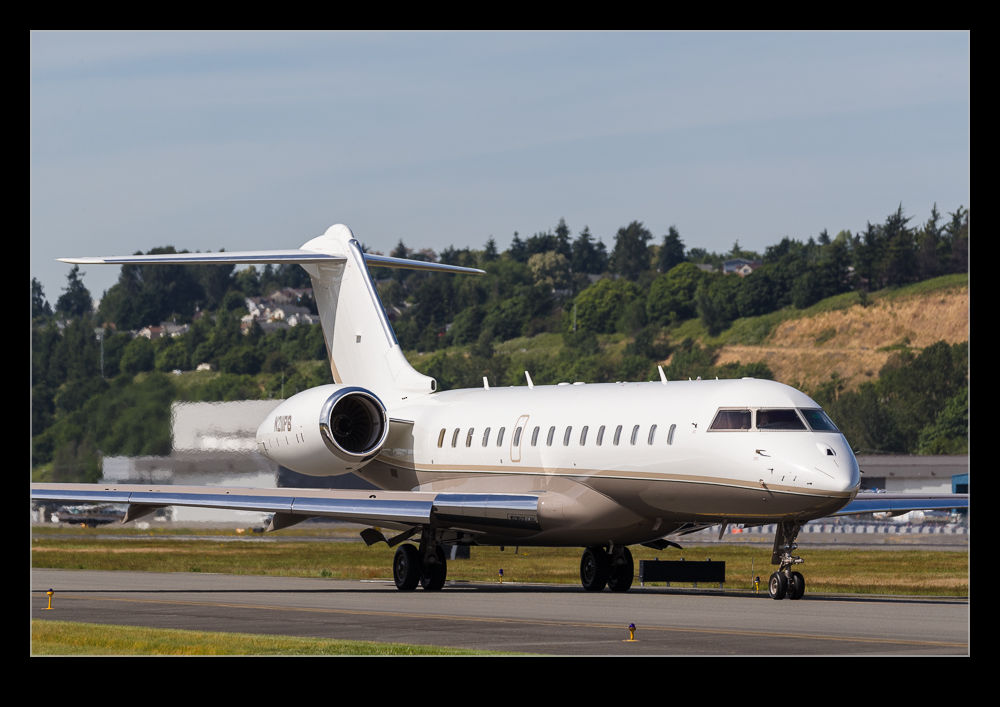 Within the space of a few minutes, two Bombardier Global Expresses took off from Boeing Field. This type is a regular feature at BFI so this is not unusual. What did catch my eye was that they appeared to have the same color scheme. If they were NetJets aircraft, that would make sense. However, they didn’t look like a fleet operator I know (not that I know them all). Is this just a standard scheme that Bombardier will finish the jet in if you don’t have a preference or were they connected? If so, was a group of people taking two jets at the same time to go to the same place? Who knows?
Within the space of a few minutes, two Bombardier Global Expresses took off from Boeing Field. This type is a regular feature at BFI so this is not unusual. What did catch my eye was that they appeared to have the same color scheme. If they were NetJets aircraft, that would make sense. However, they didn’t look like a fleet operator I know (not that I know them all). Is this just a standard scheme that Bombardier will finish the jet in if you don’t have a preference or were they connected? If so, was a group of people taking two jets at the same time to go to the same place? Who knows?
A Pair of T-33s, How Nice
 A previous post talked about wanting to get the Boeing T-33s after having seen one of them flying over my office. I saw that two T-33s were actually operating out of St Louis. They appeared to be operating with the Catfish 757 testbed. A couple of days later I happened to see that the two jets were operating cross country, presumably en route back from St Louis to Seattle. Sure enough, that was what they were doing.
A previous post talked about wanting to get the Boeing T-33s after having seen one of them flying over my office. I saw that two T-33s were actually operating out of St Louis. They appeared to be operating with the Catfish 757 testbed. A couple of days later I happened to see that the two jets were operating cross country, presumably en route back from St Louis to Seattle. Sure enough, that was what they were doing.
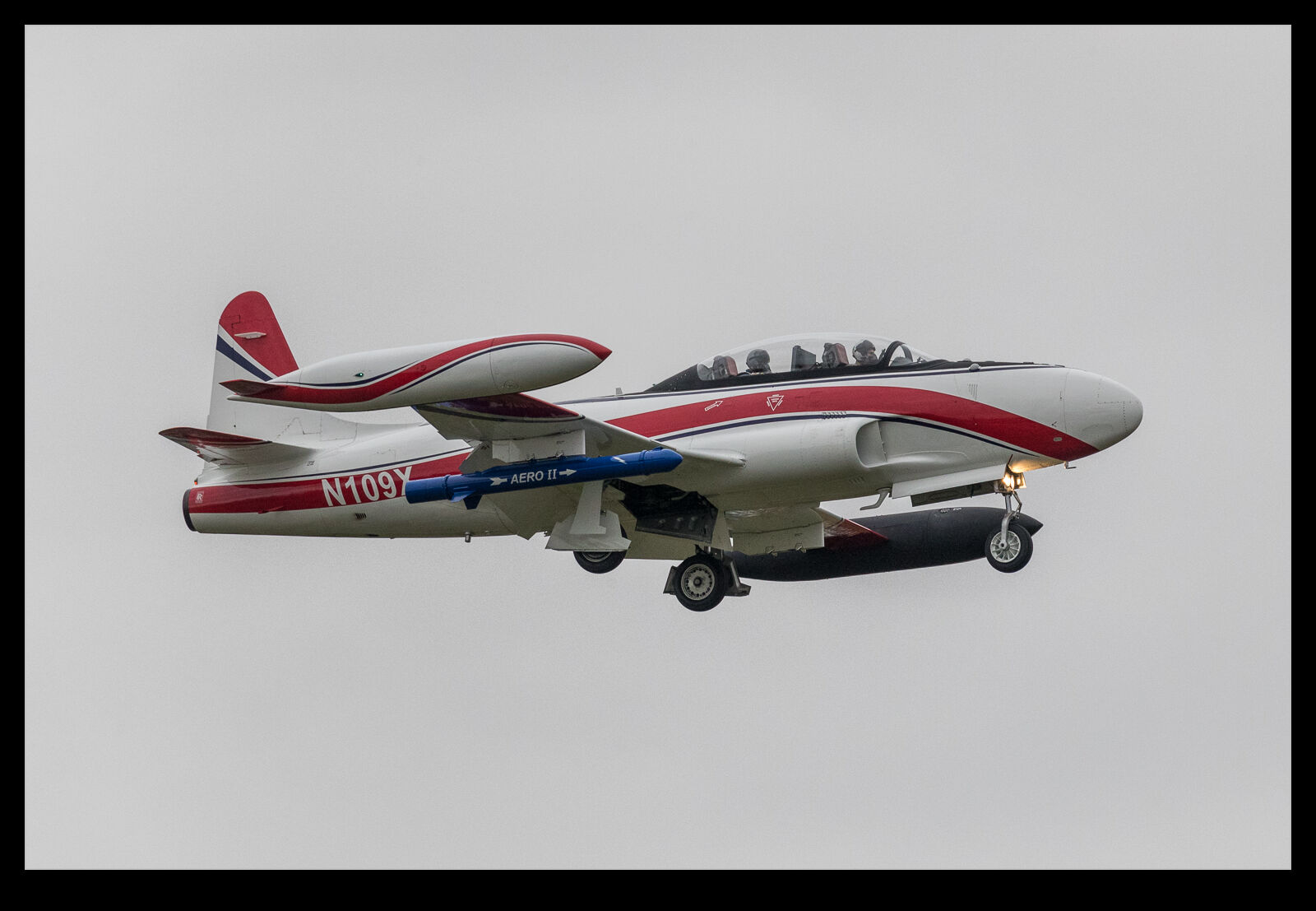 I was able to get to Boeing Field when they were completing the return journey. The tow jets were operating about ten minutes apart. The weather wasn’t great, unfortunately. There had been some nice sun a little earlier but, by the time they arrived, the clouds had rolled in. Even so, it was good to catch both jets. One of them was operating solo but the other had someone in the backseat who seemed to spot me and watched me most of the way down the approach.
I was able to get to Boeing Field when they were completing the return journey. The tow jets were operating about ten minutes apart. The weather wasn’t great, unfortunately. There had been some nice sun a little earlier but, by the time they arrived, the clouds had rolled in. Even so, it was good to catch both jets. One of them was operating solo but the other had someone in the backseat who seemed to spot me and watched me most of the way down the approach.
BA 747 Formation with a Cessna?
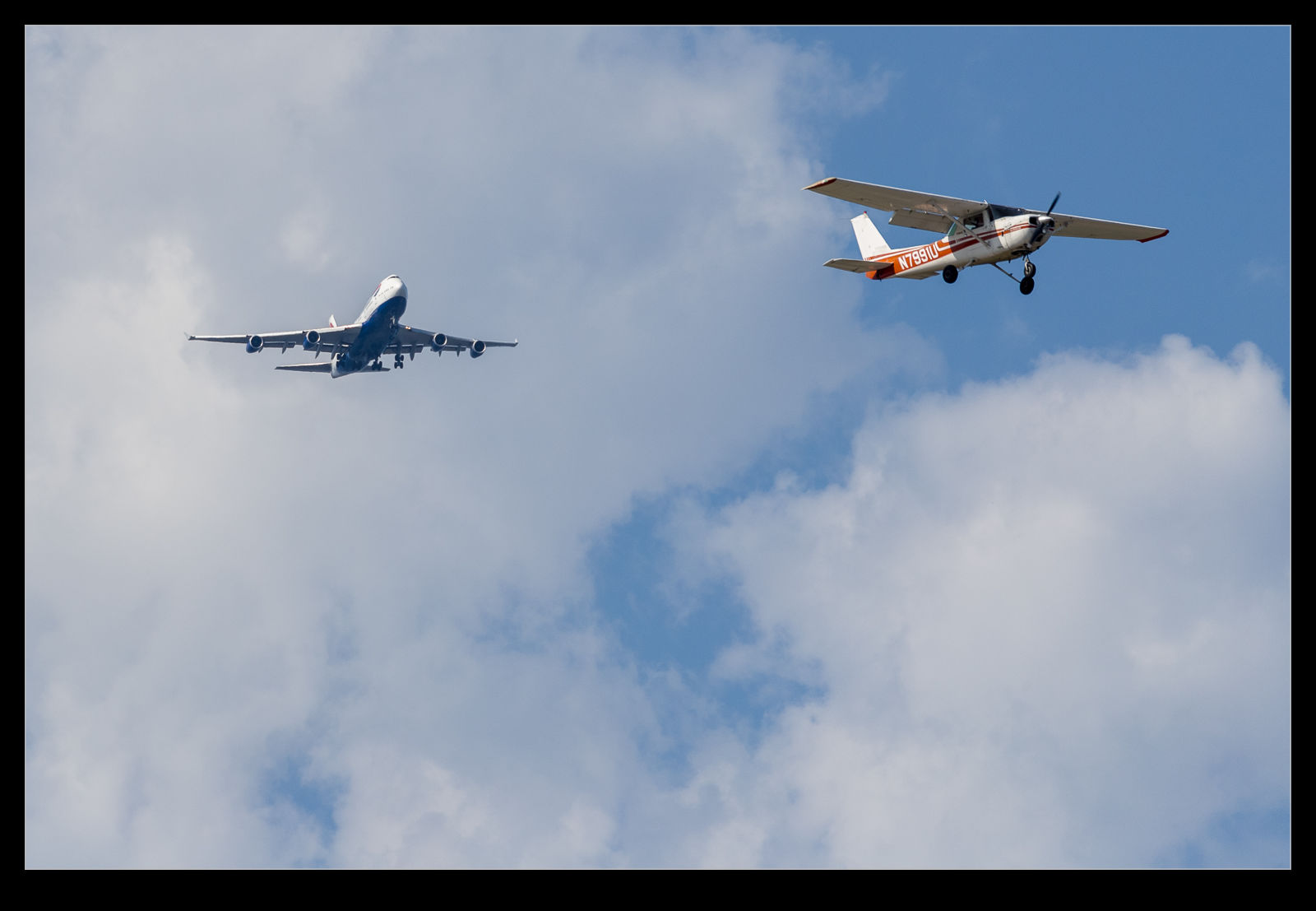 The path of jets into SeaTac from the north takes them right over Boeing Field. Sometimes, when you are watching something on one path, something going into the other field gets in your field of view. Either that or a British Airways Boeing 747-400 decided to sneak up on a Cessna. Knowing some guys who fly for them, I wouldn’t rule it out.
The path of jets into SeaTac from the north takes them right over Boeing Field. Sometimes, when you are watching something on one path, something going into the other field gets in your field of view. Either that or a British Airways Boeing 747-400 decided to sneak up on a Cessna. Knowing some guys who fly for them, I wouldn’t rule it out.
